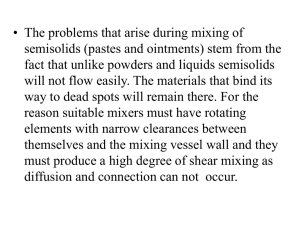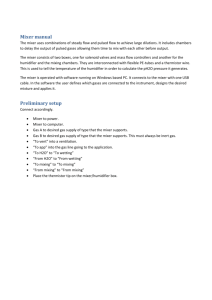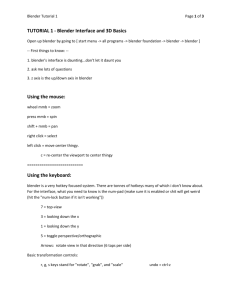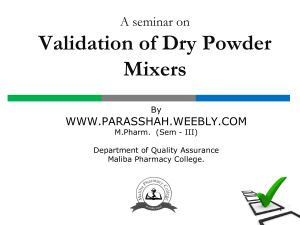Mixing and Blending Glossary - Powder and Bulk Engineering
advertisement
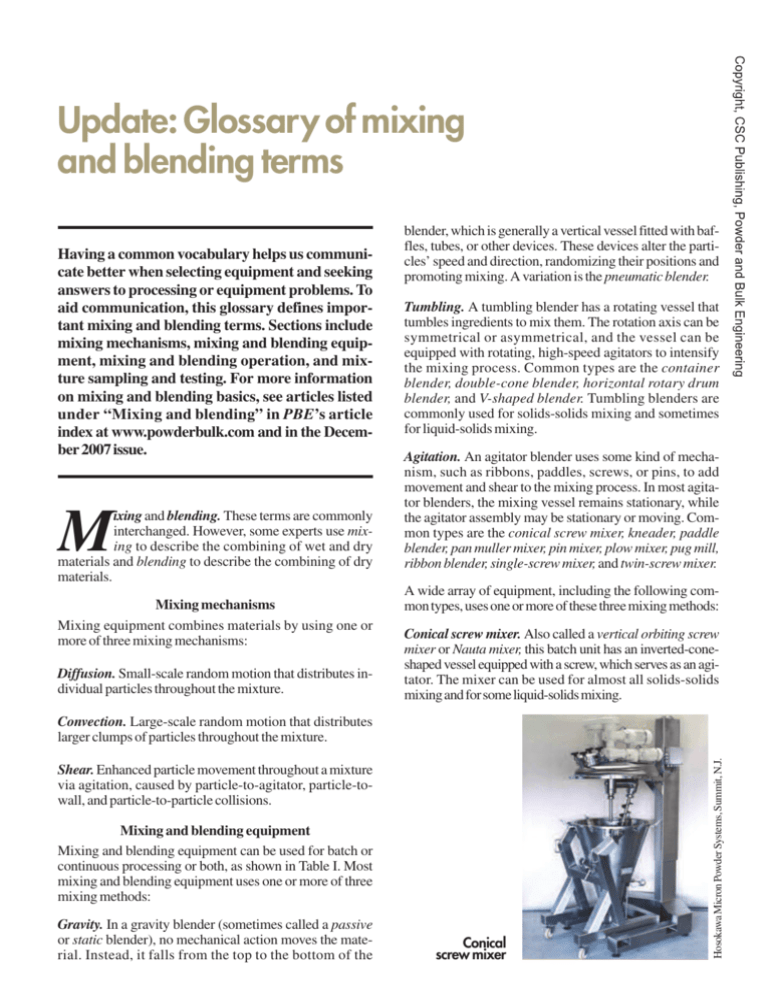
Having a common vocabulary helps us communicate better when selecting equipment and seeking answers to processing or equipment problems. To aid communication, this glossary defines important mixing and blending terms. Sections include mixing mechanisms, mixing and blending equipment, mixing and blending operation, and mixture sampling and testing. For more information on mixing and blending basics, see articles listed under “Mixing and blending” in PBE’s article index at www.powderbulk.com and in the December 2007 issue. M ixing and blending. These terms are commonly interchanged. However, some experts use mixing to describe the combining of wet and dry materials and blending to describe the combining of dry materials. Mixing mechanisms Mixing equipment combines materials by using one or more of three mixing mechanisms: Diffusion. Small-scale random motion that distributes individual particles throughout the mixture. blender, which is generally a vertical vessel fitted with baffles, tubes, or other devices. These devices alter the particles’ speed and direction, randomizing their positions and promoting mixing. A variation is the pneumatic blender. Tumbling. A tumbling blender has a rotating vessel that tumbles ingredients to mix them. The rotation axis can be symmetrical or asymmetrical, and the vessel can be equipped with rotating, high-speed agitators to intensify the mixing process. Common types are the container blender, double-cone blender, horizontal rotary drum blender, and V-shaped blender. Tumbling blenders are commonly used for solids-solids mixing and sometimes for liquid-solids mixing. Agitation. An agitator blender uses some kind of mechanism, such as ribbons, paddles, screws, or pins, to add movement and shear to the mixing process. In most agitator blenders, the mixing vessel remains stationary, while the agitator assembly may be stationary or moving. Common types are the conical screw mixer, kneader, paddle blender, pan muller mixer, pin mixer, plow mixer, pug mill, ribbon blender, single-screw mixer, and twin-screw mixer. A wide array of equipment, including the following common types, uses one or more of these three mixing methods: Conical screw mixer. Also called a vertical orbiting screw mixer or Nauta mixer, this batch unit has an inverted-coneshaped vessel equipped with a screw, which serves as an agitator. The mixer can be used for almost all solids-solids mixing and for some liquid-solids mixing. Shear. Enhanced particle movement throughout a mixture via agitation, caused by particle-to-agitator, particle-towall, and particle-to-particle collisions. Mixing and blending equipment Mixing and blending equipment can be used for batch or continuous processing or both, as shown in Table I. Most mixing and blending equipment uses one or more of three mixing methods: Gravity. In a gravity blender (sometimes called a passive or static blender), no mechanical action moves the material. Instead, it falls from the top to the bottom of the Conical screw mixer Hosokawa Micron Powder Systems, Summit, N.J. Convection. Large-scale random motion that distributes larger clumps of particles throughout the mixture. Copyright, CSC Publishing, Powder and Bulk Engineering Update: Glossary of mixing and blending terms Copyright, CSC Publishing, Powder and Bulk Engineering Table l Mixing and blending methods and example equipment Method Gravity Tumblinga Agitation Equipment type (alternate names) Liquid-solids mixing Solids-solids blending Batch 3 Gravity blender 3 Pneumatic blender 3 Container blender 3 3 Continuous 3 3 Double-cone blender 3 3 3 Horizontal rotary drum blender (cylindrical blender) 3 3 3 V-shaped blender (twin-shell blender) 3 3 3 Conical screw mixer (vertical orbiting screw mixer, Nauta mixer) 3 3 3 Kneader (double-arm mixer, dough mixer) 3 Paddle blender 3 Pan muller mixer 3 Pin mixer 3 Plow mixer 3 3 Pug mill 3 3 Ribbon blender 3 3 Single-screw mixer (extruder) 3 3 Twin-screw mixer 3 3 3 3 3 3 3 3 3 3 3 3 Note: Many tumbling mixers can be fitted with agitators to intensify the mixing process and with liquid-addition equipment. a Container blender. A rigid intermediate bulk container (RIBC) already filled with dry ingredients is placed in (typically) a stand-alone pedestal-supported cradle. The cradle holds and rotates the container to mix the ingredients, turning the container itself into a batch blender vessel, which eliminates many material handling steps as well as dust and contamination problems. The blender is mounted between two trunnions that permit the unit to tumble end over end. This batch unit can be equipped with a spray line for liquid addition and an agitator for delumping. Tote Systems, Burleson, Tex. Double-cone blender. This blender consists of two coneshaped sections welded at their wide ends to a center band. Continental Products, Milwaukee, Wis. Horizontal rotary drum blender. Also called a cylindrical blender, this batch unit is a tubular vessel mounted on trunnions. Internal baffles or lifter bars are mounted along the Container blender (double-pedestal type) Horizontal rotary drum blender Kneader. Also called a double-arm mixer or dough mixer, this batch unit has two horizontal, counter-rotating, Zshaped agitators positioned in a W-shaped trough. It’s used primarily for liquid-solids mixing to form pastes, liquids, and plastic masses with extremely high viscosities (over 100,000 centipoise). Paddle blender. This blender has a U-shaped trough equipped with a rotating shaft fitted with paddles. As the shaft rotates, the paddles lift the material from the bottom of the trough into the material mass. The unit can also blend small amounts of liquid with solids and is available in models for batch or continuous processing. Pan muller mixer. This batch unit is a flat-bottomed, cylindrical, pan-shaped vessel equipped with agitators (such as large rotating plows) and scrapers; either the pan or the agitators rotate, and the scrapers push the material into the agitators’ path, breaking down lumps and blending the material. A continuous muller is a series of two or more intersecting and communicating pans, each with its own agitators and scrapers. Mullers are used primarily for liquid-solids mixing to form pastes. Pug mill. This continuous unit has a drum- or troughshaped vessel equipped with a double-shafted or (less often) single-shafted agitator, with adjustable paddles mounted on each shaft. The machine has wide tolerances, which promotes mass mixing, and can handle very large volumes. It’s often used for very crude solids mixing, such as preparing clay for brick forming. Ribbon blender. This blender’s U-shaped trough is equipped with a rotating shaft typically fitted with helical blades called ribbons. It’s considered the workhorse of solids-solids mixing and can also blend small amounts of liquid with solids. It’s available in batch and continuous processing models. Single-screw mixer. Also called an extruder, this continuous unit mixes material via a fusion process using heat transfer, friction, and pressure. Used primarily in plastics production, the machine consists of a barrel-shaped vessel equipped with a screw that mixes the major and minor ingredients, then forces the finished mixture through a die, shaping it into strands, pellets, or a specific profile. The unit is also available with dual screws. Plow mixer. This batch unit has a stationary cylindrical vessel and a rotating shaft mounted in the vessel’s center. Several plows are welded to the shaft. The shaft rotates at high speed, throwing the material upward, and the material settles in a random pattern. This high-shear mixer can be equipped with high-speed choppers to break up agglomerates and spray nozzles to add liquids. Nol-Tec Systems, Lino Lakes, Minn. Pin mixer. This continuous unit has a cylindrical vessel and a single shaft that rotates at high speed and is fitted with radial pins or narrow paddles. It’s used primarily for mixing a small amount of liquid with solids to produce microsized pellets or to dedust incoming solids. Pneumatic blender Munson Machinery, Utica, N.Y. Charles Ross & Son, Hauppauge, N.Y. Pneumatic blender. This continuous blending device injects gentle blasts of compressed air into a material bed in a silo or bin, lifting the material upward and outward in a continuous circular motion, producing a homogeneous blend. Plow mixer Ribbon blender Copyright, CSC Publishing, Powder and Bulk Engineering vessel’s inner walls. The vessel rotates on a horizontal axis and the internal baffles gently lift, aerate, delump, and blend the material. V-shaped blender. Also called a twin-shell V blender (because of the V-shaped vessel’s twin “legs”), this batch blender rotates, tumbling the ingredients to mix them. It may be equipped with baffles, breaker bars, or other components to break up agglomerates and enhance mixing. It’s generally used for blending dry ingredients but may also be fitted with liquid-addition equipment. Mixing and blending operation Batch mixing. All ingredients are loaded into the mixing vessel and blended until they’re homogeneously dispersed or mixed; the mixture is then completely unloaded before another batch is begun. Mixture sampling and testing Sampling and testing are important elements of most mixing operations. In many cases, sampling is done frequently throughout the process. In others, it’s done several times until the right mix has been achieved, then less frequently to ensure that the mix continues to be on spec. Testing helps determine such factors as the appropriate mixing time and when and where segregation occurs. Sampling and testing can be done manually (for example, by scooping a sample out of a mixture with a cup) or automatically with an automatic sampling device. Sample testing and analysis can be done on-line while mixing or in a laboratory. Acceptable mixture variation. This is the acceptable range of blend homogeneity variation in a set of samples for a required mixture. Gross characteristics. These are the mixture characteristics (such as color) that are apparent without sampling and laboratory testing. Continuous mixing. Ingredients are continuously fed through a process-line mixing vessel. The mixture is continuously discharged to the next equipment in the process line. Sampling device. Several sampling devices are available to take material samples from a mixer. They range from a simple cup or scoop to highly sophisticated automatic devices. Mixing specification. These specific instructions for a mixing operation aim to minimize mixture variability even when different operators are involved. The specification includes the list of ingredients to be added, the order in which each is to be added, and the speed at which each is to be added; it can also include mixing speed, ingredient and operating temperatures, and other variables. Sampling interval. This is the time interval between samples; samples can be taken at several intervals throughout the mixing cycle to determine precisely when uniform mixing is achieved and thus determine the optimal mixing time. Premixing. It’s sometimes advantageous to mix a formula’s minor or micro ingredients into a premix (also called a master batch) that’s later added to the mixing vessel containing the major ingredients. Using a premix can aid the uniform dispersion of the minor ingredients into the larger batch. A premix can also aid the uniform dispersion of ingredients with extremely different characteristics (such as particle size, shape, or moisture content). Patterson Process Equipment, Newark, Del. Segregation. The mixture’s ingredients separate (unmix or demix), often as the result of overmixing. V-shaped blender (lab-size unit) Sampling specification. These detailed instructions explain how and where an operator will take samples from a mixer to minimize sampling differences between operators and between batches. Thief sampler. This common and simple sampling device can capture a representative blend sample without disturbing the blend. The device consists of two tubes, one inside the other, each with a hole in its sidewall. The device is inserted into the mixer and the tubes are twisted to align the holes, allowing material to enter the device. The tubes are then twisted to seal the holes, and the device is removed from the mixer with a sample ready for analysis. PBE Editor’s note The information in this article has been adapted from past Powder and Bulk Engineering articles. We thank Peter R. Holman, Holman Engineering, for reviewing the article. Copyright, CSC Publishing, Powder and Bulk Engineering Twin-screw mixer. This continuous unit is basically a pug mill, but it’s manufactured to more exact tolerances and equipped with a very sophisticated twin-screw agitator, which is sometimes fitted with paddles. This mixer is commonly used for liquid-solids mixing to produce pastes and plastic compounds.

